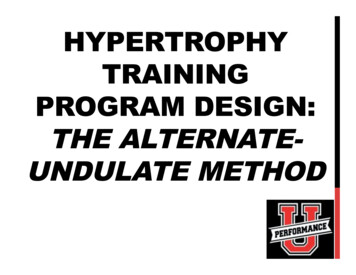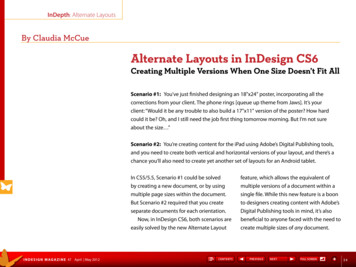
Transcription
HYPERTROPHYTRAININGPROGRAM DESIGN:THE ALTERNATEUNDULATE METHOD
OBJECTIVES- To learn the Performance U Alternate-Undulatemethod for designing hypertrophy (i.e.,bodybuilding) programs.- To provide you with a scientifically-founded,and battle-tested training system that offers youa repeatable and individualizable framework touse with clients looking to maximize musclegrowth.“Training is the art of expressing the science.”
WE DON’T START BEGINNERSWITH THE ALT-UND METHODBeginner clients (with no priortraining base, or those who’recoming off a an extendedtime away from resistancetraining) are first placed on a“break-in” program (generallyfor 2-3 weeks), then on a“Muscle-Base” program(generally for 4-5 weeks)such as the ones found in myStrength Training For FatLoss book.
“If I want to teachyou nothing, I’lltry to teach youeverything.” –Renzo Gracie
QUICK REVIEW: THE 3 MECHANISMSOF HYPERTROPHYMuscle Tension: This is the tension exerted on the muscles to reduce, produce orcontrol force. Both lifting heavy loads for lower volumes and lifting lighter loads forhigher volumes can bring about muscle tension, and, therefore create a stimulus formuscle growth.Muscle Damage: This refers to microtears in the muscle tissue (e.g., eccentricoverloading), which often lead to delayed-onset of muscle soreness (DOMS) after anintense exercise session. Muscle Damage can occur from either mechanical orchemical stress. From a chemical perspective, during repetitive effort orientedexercise such as high-rep sets, when you’re using more oxygen, reactive oxygenspecies (ROS) or free radicals form. These ROS can cause muscle damage.Metabolic Stress: Increasing Time Under Tension (TUT) increases metabolic stressand will give you an incredible pump, and this muscle cell swelling (i.e. muscle pump)can cause both an increase in protein synthesis and a decrease in protein breakdown.The mechanisms of muscle hypertrophy and their application to resistancetraining.
SETS AND REPSA 2002 study published in the Journal of Strength and ConditioningResearch study compared two groups. One group did performed sets of 8reps during weeks 1-4, 6 reps during weeks 4-8, and 4 reps during weeks9-12. The other training group did the same exercise, but altered their setsand reps on a daily basis. For the 12-weeks of training, here’s what theydid: Monday, 8 reps; Wednesday, 6 reps; Friday, 4 reps.The results of this study showed that making set/rep alterations on adaily basis was more effective in eliciting strength gains than doingso every 4 weeks.More recent studies have not only also found that daily intensity andvolume (set/rep) variations was more effective than weekly volumevariations for increases in maximal strength, but using dailyundulating sets/rep scheme also may leads to greater gains inmuscle size and thickness.
THE PRACTICAL TAKE AWAYTo build muscle we need to create a training environmentthat elicits:Muscle tension via heavy loads and medium loads lifted tofatigue.Muscle damage by focusing on a controlled eccentric.Metabolic stress by getting a pump.AND, we need to provide an Undulating set/rep scheme.Also, we cannot forget about honoring the principle ofprogressive overload (i.e., linear progress).
cises:Alternateeachworkoutbetween3x12- ‐15&4x6- ‐8
REDExercise:Perform747Repschemex3- 3x12- ‐15&4x6- ‐8
PERFORMANCE U SET PROTOCOLSSET SPICERSOVERLOAD PROTOCOLS1.5 setsHeavy Contrast setsIso-Dynamic setsHeavy setsPG and GP setsHeavy Drop-sets 4 4PGE and GPE setsVolume ContrastsComplexes747 sets“Intensification Phase” Load Phase“Accumulation Phase” Volume PhaseFINISHERSNew Type 21s28’sIso-Dynamic Countdown setsDrop setsTriple Threat sets
REP TEMPO-I don’t get caught up with these three or four digit rep tempos (e.g., 3-2-1or 3-2-1-1), I’ve found it confuse and distracts.-If I want you to lift the load (concentrically) slower, I’ll give you a heavierload. And, if I want you to lift the load (concentrically) faster, I’ll give you alighter load.-I always ask clients to demonstrate “deliberate control” on the eccentricportion of each rep.-On heavy lifts (i.e., lower rep sets of 8 or less), I ask the client to “explodeinto each concentric.”-On exercises done for 9 reps or more, I ask the client to perform theconcentric in a “normal tempo.”-Also, on exercises done for 9 reps or more, I generally ask the client to“avoid the lockout.”Note: Clients who demonstrate hypermobility are always instructed to avoidthe lockout in their hyperbole areas.
REST BETWEEN SETS?- Rest time depends on male or female, one’sfitness level and the intensity of the set.- “Rest as much as you need, and as little asyou have to.”- In order to perform the next set whiledisplaying good control in the technique andROM we asked for.
VOLUME DISTRIBUTION AND FOCUSOF WEEKLY TRAINING SPLITWe provide more volume on (andprioritize) the muscle groupsthey’re looking to “bring up” –most commonly the back,hamstrings and glutes – andspend less volume on (and makeless of a priority) their stronger,more developed areas.
WEEKLY WORKOUT SPLITS-If training 3x per week, we’ll use 3 total-body workouts.-If training 4 or more days per week, we’ll use a body-part split.-If training 5-6x per week, we’ll stick with 3-4 different workoutsper program, and have the individual cycle through those.Example of a 3 split performed five days per week:Mon: PushingTues: PullingWed: Lower-bodyThurs: RestFri: PushingSat: PullingSun: Rest
COACHING TIPS ON HYPERTROPHYFOCUSED PROGRAMMING:- Don’t avoid machines!- Limit exercises that involve momentum.- Focus on technique instead of load.- Both horizontal and vertical pulling movementshelp to develop the lats, but it’s horizontal pullingexercises that really develop the mid-back muscles.- Change up the point of maximal muscle loading(see graph on next slide).
ARE ALL HIP EXTENSIONEXERCISES CREATED EQUAL?
UNDULATING CARDIO/CONDITIONINGThe Alternate-Undulate method does incorporate SMIT, HIITand Steady state cardio training when we feel necessary.Put simply, the type of cardio-conditioning you docorresponds to the set/rep scheme used in the precedingstrength training portion of the workout. In other words, thecardio-conditioning is undulated just like the strengthtraining. On the days where your strength training workoutsare the longest, your cardio-conditioning activities are theshortest and vice versa. This keeps your workout timeconsistent, but workout activities highly varied.
THANK YOU!PerformanceU.net
REFERENCES:Schoenfeld BJ. The mechanisms of muscle hypertrophy and their application to resistancetraining. J Strength Cond Res. 2010 Oct;24(10):2857-72.Rhea MR, Ball SD, et al. A comparison of linear and daily undulating periodized programswith equated volume and intensity for strength. J Strength Cond Res. 2002 May;16(2):250-5.Willardson, J. "A Brief Review: Factors Affecting the Length of the Rest Interval BetweenResistance Exercise Sets." Journal of Strength and Conditoning Research, 2006, 20(4),978–984.Freitas de Salles, et al. Rest Interval between Sets in Strength Training. American Journal ofSports Medicine, 2009; 39 (9): 765-777.M. Contreras, Bret MA, et al. Are All Hip Extension Exercises Created Equal? Strength &Conditioning Journal: April 2013 - Volume 35 - Issue 2 - p 17–22DeFreitas JM, et al. An examination of the time course of training-induced skeletal musclehypertrophy. Eur J Appl Physiol. 2011 Nov;111(11):2785-90.
The Alternate-Undulate method does incorporate SMIT, HIIT and Steady state cardio training when we feel necessary. Put simply, the type of cardio-conditioning you do corresponds to the set/rep scheme used in the preceding strength training portion of the workout. In other words, the cardio-conditioning is undulated just like the strength training.










